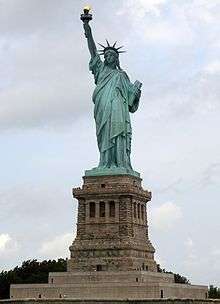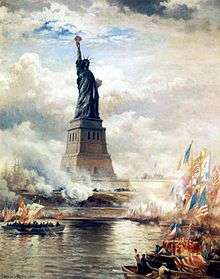The New Colossus
"The New Colossus" is a sonnet by American poet Emma Lazarus (1849–1887). She wrote the poem in 1883 to raise money for the construction of a pedestal for the Statue of Liberty (Liberty Enlightening the World).[2] In 1903, the poem was cast onto a bronze plaque and mounted inside the pedestal's lower level.
| The New Colossus | |
|---|---|
 Emma Lazarus' manuscript | |
| Created | 1883 |
| Location | Statue of Liberty, Liberty Island, New York City, New York, U.S.[1] |
| Author(s) | Emma Lazarus |
| Purpose | To raise money for construction of the statue's pedestal |
History of the poem

This poem was written as a donation to an auction of art and literary works[3] conducted by the "Art Loan Fund Exhibition in Aid of the Bartholdi Pedestal Fund for the Statue of Liberty" to raise money for the pedestal's construction.[4] Lazarus's contribution was solicited by fundraiser William Maxwell Evarts. Initially she refused but writer Constance Cary Harrison convinced her that the statue would be of great significance to immigrants sailing into the harbor.[5]
"The New Colossus" was the first entry read at the exhibit's opening on November 2, 1883. It remained associated with the exhibit through a published catalog until the exhibit closed after the pedestal was fully funded in August 1885,[6][7] but was forgotten and played no role at the opening of the statue in 1886. It was, however, published in Joseph Pulitzer's New York World as well as The New York Times during this time period.[8] In 1901, Lazarus's friend Georgina Schuyler began an effort to memorialize Lazarus and her poem, which succeeded in 1903 when a plaque bearing the text of the poem was put on the inner wall of the pedestal of the Statue of Liberty.[4]

On the plaque hanging inside the Statue of Liberty, the line "Keep ancient lands, your storied pomp!" is missing a comma, and reads in Lazarus's manuscript "Keep, ancient lands, your storied pomp!"[9] since its unveiling in 1903. The plaque also describes itself as an engraving; it is actually a casting.
The original manuscript is held by the American Jewish Historical Society.[10]
Text of the poem

"With conquering limbs astride from land to land".
Not like the brazen giant of Greek fame,
With conquering limbs astride from land to land;
Here at our sea-washed, sunset gates shall stand
A mighty woman with a torch, whose flame
Is the imprisoned lightning, and her name
Mother of Exiles. From her beacon-hand
Glows world-wide welcome; her mild eyes command
The air-bridged harbor that twin cities frame.
"Keep, ancient lands, your storied pomp!" cries she
With silent lips. "Give me your tired, your poor,
Your huddled masses yearning to breathe free,
The wretched refuse of your teeming shore.
Send these, the homeless, tempest-tost to me,
I lift my lamp beside the golden door!"[11]
Interpretation
The poem is a Petrarchan sonnet.[12]
The title of the poem and the first two lines reference the Greek Colossus of Rhodes, one of the Seven Wonders of the Ancient World, a famously gigantic sculpture that stood beside or straddled across the entrance to the harbor of the island of Rhodes in the 3rd century BC. In the poem, Lazarus contrasts that ancient symbol of grandeur and empire ("the brazen giant of Greek fame") with a "New" Colossus – the Statue of Liberty, a female embodiment of commanding "maternal strength" ("Mother of Exiles").[12][13]

The "sea-washed, sunset gates" are the mouths of the Hudson and East Rivers, to the west of Brooklyn. The "imprisoned lightning" refers to the electric light in the torch, then a novelty.
The "air-bridged harbor that twin cities frame" refers to New York Harbor between New York City and Brooklyn, which were separate cities at the time the poem was written, before being consolidated as boroughs of the City of Greater New York in 1898.[13]
The "huddled masses" refers to the large numbers of immigrants arriving in the United States in the 1880s, particularly through the port of New York via Ellis Island.[14] Lazarus was an activist and advocate for Jewish refugees fleeing persecution in Czarist Russia.[15]
Influence
Immigration to the United States
Paul Auster wrote that "Bartholdi's gigantic effigy was originally intended as a monument to the principles of international republicanism, but 'The New Colossus' reinvented the statue's purpose, turning Liberty into a welcoming mother, a symbol of hope to the outcasts and downtrodden of the world."[16]
John T. Cunningham wrote that "The Statue of Liberty was not conceived and sculpted as a symbol of immigration, but it quickly became so as immigrant ships passed under the torch and the shining face, heading toward Ellis Island. However, it was [Lazarus's poem] that permanently stamped on Miss Liberty the role of unofficial greeter of incoming immigrants."[17]
The poem has entered the political realm. It was quoted in John F. Kennedy's book A Nation of Immigrants (1958)[18] as well as a 2010 political speech by President Obama advocating immigration policy reform.[19] On August 2, 2017, the poem and its importance to the Statue of Liberty's symbolism, and thus the effect on American immigration policy, was debated in a White House briefing.[20]
On August 12, 2019, Ken Cuccinelli, acting director of US Citizenship and Immigration Services, revised a line from the poem to outline a new immigration policy that would evaluate potential visa/green card immigrants on the basis of income and education, stating: "Give me your tired, your poor who can stand on their own two feet and who will not become a public charge."[22][23][24]
Ron Charles in the Washington Post was among many who criticized Cuccinelli's interpretation of the poem, stating:
There’s something obscene about Cuccinelli’s efforts to contort Lazarus’s words of welcome into a litmus test of economic self-sufficiency. Over the decades, “The New Colossus” has acquired a patina of universality. Its phrases are as familiar to us as “The Star-Spangled Banner” or the opening lines of the Declaration of Independence. Staining “The New Colossus” with the bile of discrimination is a shameful act of cultural defilement.[25]
In culture
Parts of the poem also appear in popular culture. The Broadway musical Miss Liberty, with music and lyrics by Irving Berlin, an immigrant himself, used the final stanza beginning "Give me your tired, your poor" as the basis for a song.[18][26] Joan Baez used the second half of the poem in her lyrics to The Ballad of Sacco and Vanzetti Part 1 which forms parts of Ennio Morricone's soundtrack to the 1971 Italian film Sacco & Vanzetti, based on the events surrounding the trial and judicial execution of the Italian-born American anarchists Nicola Sacco and Bartolomeo Vanzetti.[27]
It was also read in the 1941 film Hold Back the Dawn as well as being recited by the heroine in Alfred Hitchcock's wartime film Saboteur.[18]
It is recited by B.J. Blazkowicz at the end of the 2014 video game Wolfenstein: The New Order. The poem is also the subtitle of the game's sequel: Wolfenstein II: The New Colossus.
Parts of the poem are recited during the final live telecast of Miss USA 2019, with the poem being recited by some of the contestants.[28]
References
- "Statue of Liberty National Monument". US: National Park Service. 2007-12-31. Retrieved 2008-07-24.
- Lazarus, Emma, The New Colossus, Liberty State Park
- Sutherland, Cara A (2003), The Statue of Liberty: The Museum of the City of New York, Barnes & Noble, p. 77, ISBN 0-7607-3890-4,
auction of art and literary work
; Mark Twain also contributed. - Young, Bette Roth (1997), Emma Lazarus in Her World: Life and Letters, The Jewish Publication Society, p. 3, ISBN 0-8276-0618-4,
…fell into obscurity. At the unveiling of the statue […] both Emma and her sonnet were absent […] Georgina Schuyler set in motion a successful attempt to memorialize her friend by placing the poem, inscribed on a bronze tablet, inside the pedestal…
. - Felder, Deborah G; Rosen, Diana L (2003), Fifty Jewish Women Who Changed the World, Citadel, p. 45, ISBN 0-8065-2443-X,
…William Maxwell Evert [sic; presumably a misspelling of "William Maxwell Evarts] asked […] Lazarus[…] to compose original works […] who […] refused […] until […] Constance Cary Harrison[…] suggested that she consider what the statue would mean to the thousand of immigrants who would see it as they sailed into New York…
. - "Image-Art Loan Fund Exhibition in Aid of the Bartholdi Pedestal Fund for the Statue of Liberty Catalogue".
- "The Statue of Liberty - Engineering, Construction, and Crossing the Atlantic".
- "National Park Service-Statue of Liberty-Emma Lazarus".
- Shapiro, Gary (2006-12-08). "Misprint is spied in Lazarus poem at Liberty island". The New York Sun. Retrieved 2007-06-08.
- Roberts, Sam (2011), "How a Sonnet Made a Statue the 'Mother of Exiles'", New York Times, retrieved 2013-11-21
- Lehman, David, ed. (2006). The Oxford Book of American Poetry. Oxford University Press. p. 184. OCLC 62697134.
- Hunter, Walt (16 January 2018). "The Story Behind the Poem on the Statue of Liberty". The Atlantic. Retrieved 14 August 2019.
- Allen, Austin (November 22, 2017). "Emma Lazarus: "The New Colossus"". Poetry Foundation. Retrieved August 13, 2019.
- "Immigration and Americanization, 1880-1930". Digital Public Library of America.
- Mettler, Katie (February 1, 2017). "'Give me your tired, your poor': The story of poet and refugee advocate Emma Lazarus". The Washington Post.
- Auster, Paul (2005), "NYC = USA", Collected Prose: Autobiographical Writings, True Stories, Critical Essays, Prefaces, and Collaborations with Artists, Picador, p. 508, ISBN 0-312-42468-X.
- Cunningham, John T (2003), Ellis Island: Immigration's Shining Center, Arcadia Publishing, pp. 46–48, ISBN 0-7385-2428-X.
- McGill, Meredith L. (2008). The Traffic in Poems: Nineteenth-century Poetry and Transatlantic Exchange. Rutgers University Press. p. 118. ISBN 9780813542300.
- Jackson, David (July 1, 2010). "Obama edits Emma Lazarus poem on Statue of Liberty". The Oval. USA Today. Retrieved July 15, 2015.
- "Trump aide dismisses Statue of Liberty "huddled masses" poem". CBS News. CBS News. August 3, 2017. Retrieved July 4, 2018.
- "Rule Would Penalize Immigrants To U.S. For Needing Benefits". NPR. August 13, 2019. Retrieved August 15, 2019.
- "Immigration official Ken Cuccinelli: Statue of Liberty poem refers to immigrants from Europe". USA Today. August 13, 2019. Retrieved August 13, 2019.
- "Trump official revises Statue of Liberty poem to defend migrant rule change". www.bbc.com. August 14, 2019. Retrieved August 14, 2019.
- "Burnett challenges Cuccinelli on new immigration rule". CNN. August 13, 2019. Retrieved November 8, 2019.
- Charles, Ron (14 August 2019). "Don't let the Trump administration vandalize Lady Liberty's inspiring message". The Washington Post. Retrieved 15 August 2019.
- Esther Schor, Emma Lazarus, Knopf Doubleday Publishing Group - 2008, page 255
- Stipes., Watts, Emily (1977). The poetry of American women from 1632 to 1945. Austin: University of Texas Press. ISBN 0292764359. OCLC 2463497.
- The New Colossus - Miss USA 2019, retrieved 2020-01-18
External links
| Wikisource has original text related to this article: |
- "A Century of Immigration, 1820–1924". Library of Congress.
Courtesy of the American Jewish Historical Society, New York and Newton Centre, Massachusetts
. Emma Lazarus' handwritten sonnet "The New Colossus" The poem itself, having been published in 1883 or at the very latest 1903 is in the public domain. - ———. Schor, Esther (ed.). The New Colossus (interactive ed.). Nextbook Press.
- Manuscript notebook from the Emma Lazarus collection at the American Jewish Historical Society. Includes an undated manuscript version of "The New Colossus".
- Cavitch, Max (2008). "Emma Lazarus and the Golem of Liberty". In The Traffic in Poems: Nineteenth-Century Poetry and Transatlantic Exchange. Meredith L. McGill (ed.). New Brunswick: Rutgers University Press. app. 97–122.
- Marom, Daniel (2000). "Who Is the 'Mother of Exiles'? An Inquiry into Jewish Aspects of Emma Lazarus's 'The New Colossus'". Prooftexts. 20 (3): 231–61. doi:10.1353/ptx.2000.0020.
